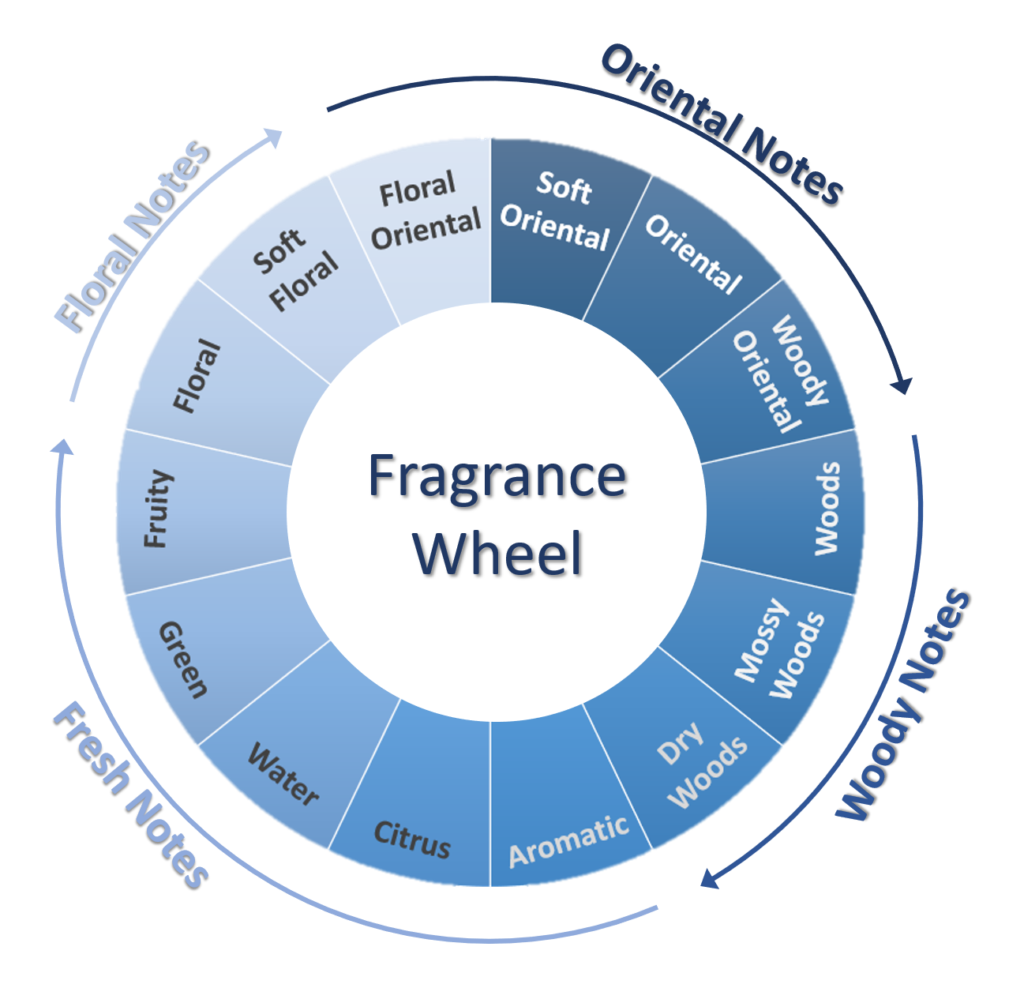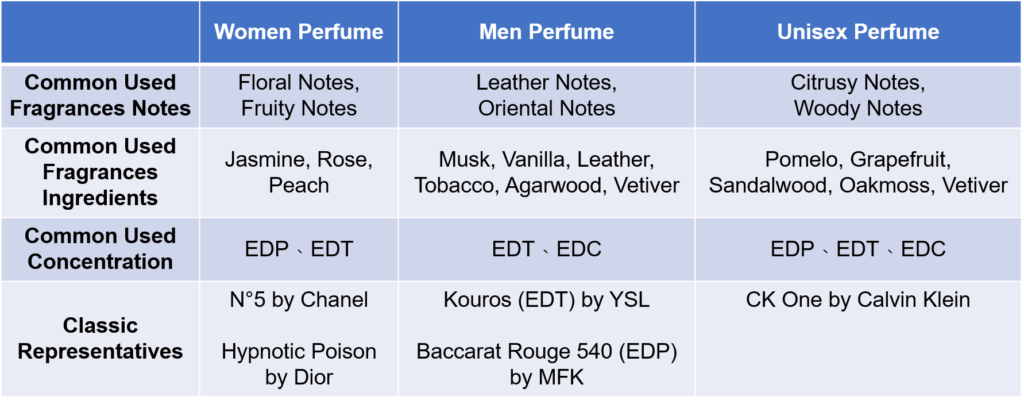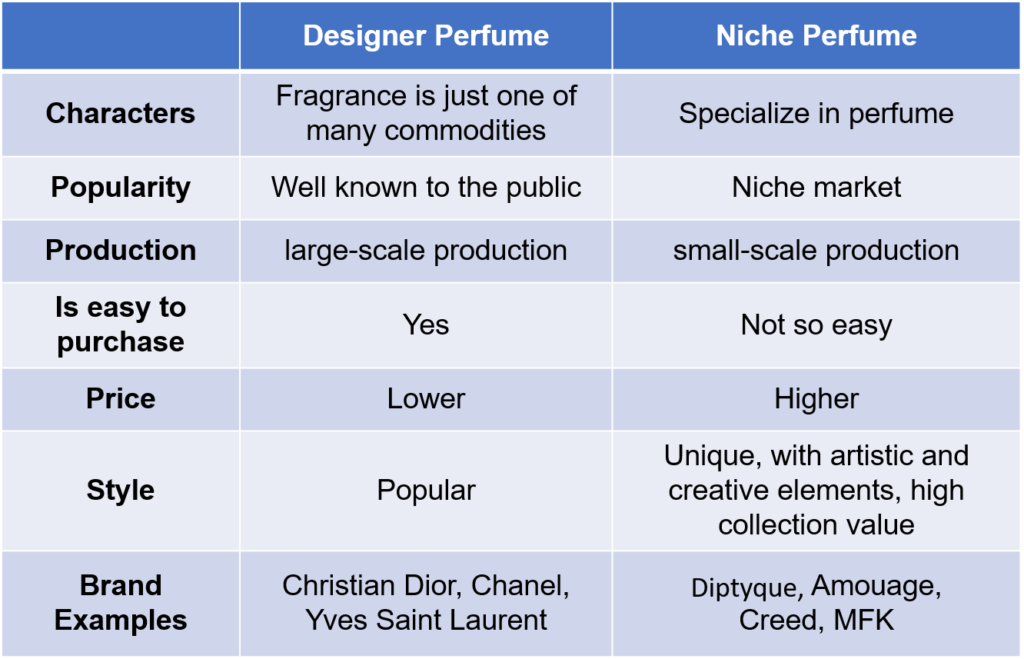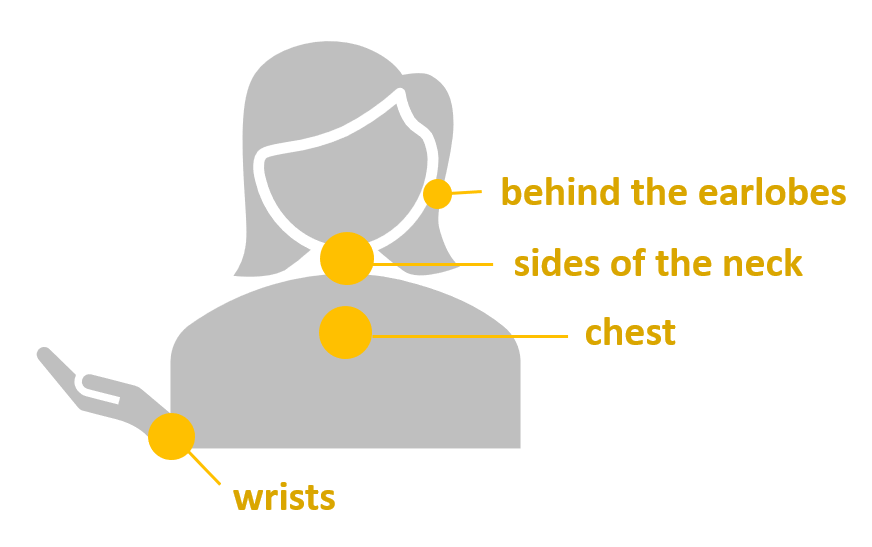About “Basic Knowledge of Perfume”
Perfume is a blend of fragrant essential oils, solvents (usually alcohol and water), fixatives, and other ingredients.
The concentration of perfume refers to the proportion of fragrance essential oils in the solvent, which determines the intensity of the scent.
Concentration can range from 1% to 40%.
1. What Are Eau De Toilette (EDT) and Eau De Parfum (EDP)?
Eau de Toilette (EDT) and Eau de Parfum (EDP) are terms used to describe the concentrations of perfumes.
There are five levels of perfume concentration, each with varying effects on the fragrance’s longevity.
Generally speaking, perfumes with higher concentrations tend to last longer on the skin.

Listed these five levels in order of concentration, from highest to lowest:
- Parfum or Extrait: Concentration ranges from 20-30%, and can even be up to 40%, resulting in a scent that lasts at least 8 hours.
- Eau de Parfum (EDP) or Parfum de Toilette (PDT): Concentration ranges from 10-20% (usually around 15%), and has a longevity of 6-8 hours. This is the most common type of perfume for women.
- Eau de Toilette (EDT): Concentration ranges from 5-15%, and has a longevity of 3-6 hours. This is the most common type of perfume for men.
- Eau de Cologne (EDC): Concentration range from 3-8%, and has a shorter longevity of 1-2 hours.
- Eau Fraîche or Aftershave: Concentration ranges from 1-3%, and has the weakest longevity of less than 1 hour.
In terms of popularity, the ranking is as follows: Eau de Parfum (EDP), Eau de Toilette (EDT), Eau de Cologne (EDC), Eau Fraîche, and lastly, Perfum.
This is because of the high concentration of fragrance essential oils in perfume, which results in a scent that is too strong and overpowering for most people’s senses. Thus, it is less well-received.
2. Do Eau De Toilette (EDT) and Eau De Parfum (EDP) Smell the Same?
Even if Eau de Toilette (EDT) and Eau de Parfum (EDP) use the same fragrance notes, they will still smell differently. At most, they are very similar.
This is because the same fragrance, but with different levels of essential, can affect the scent’s obviousness and the performance of other fragrances.
For example, a higher dose of patchouli can make its scent more prominent, but it can also make the scent of orange blossom relatively weaker.
3. What Are Fragrance Notes?
Fragrance notes reveal the ingredients used in perfume and are categorized into top, middle, and base notes.
These notes differ in terms of when they appear and how long they last, and they typically use distinct ingredients.
Top Notes or Headnotes
Top notes are the initial scents people detect when they apply perfume.
Top notes dissipate quickly, lasting for about 5-15 minutes.
Like the opening of a musical piece, they create the first impression and establish the groundwork for the subsequent changes in scent.
Top notes frequently use citrus fragrances such as lemon and orange, or light floral fragrances like lavender and rose.
Middle Notes or Heart Notes
Middle notes constitute 70% of the fragrance and appear after the top notes fade, lasting approximately 20-60 minutes.
They serve as a bridge connecting the top and base notes, not only giving the perfume life but enriching the overall fragrance experience.
Middle notes use richer ingredients like jasmine, cinnamon, and lemongrass.
Base notes
Base notes create the foundation of the perfume and emerge about 30 minutes after application, lasting the longest for several hours.
They are employed to amplify the intensity of perfume and usually have a heavier and richer scent.
Base notes frequently use woody ingredients such as vanilla, musk, and sandalwood.

4. What Are Longevity, Projection, and Sillage?
Longevity, projection, and sillage are terms used to describe the performance of a perfume.
Longevity refers to how long the scent of perfume can still be detected on the skin after application.
The longer the scent lasts, the higher the perfume’s longevity. However, many factors can influence longevity, including:
- Concentration: In general, the higher the concentration, the longer the fragrance lasts.
- Ingredients and fragrance notes: Light floral scents or lighter fragrances like fresh, citrus and oceanic tones usually don’t last as long.
- Proportion of fragrance notes: If the proportion of base notes is higher than that of top and middle notes, the fragrance can last longer.
- Fixatives: If the perfume contains fixatives, it can extend the duration of the scent.
- Formula blending: Blending multiple formulas can help the scent linger on the skin.
- Extraction method: Rose essential oil extracted by hydro-distillation can only last a few hours, while extracted by the Attar method can last more than a day.
- Skin moisturization level: Moisturized and oiled skin can help the perfume adhere to the body and last longer.
- Body temperature: Body temperature affects the rate of evaporation, with higher body temperature leading to faster evaporation and shorter duration of the fragrance.
- Application location: Applying perfume to areas like the wrist, behind the earlobe, and at the base of the neck can help the fragrance last longer.
In addition to concentration and longevity, we also use “projection” and “sillage” to describe perfumes.
These two characteristics are often confused with each other.
Projection refers to how far a fragrance diffuses from the wearer when they are stationary.
Sillage is the scent trail left by the wearer as they are moving, such as when they leave an elevator or walk down a hallway.
High projection often correlates with high sillage, but there are exceptions.
Following is an example of high projection, but low sillage:
Some fragrances for men with citrus or marine notes may be easily detectable from a distance, but may not leave a strong scent trail after the wearer has moved away.
About “How to Choose a Perfume?”
When choosing a perfume, there are several factors you can consider to determine if it’s the right fit for you:
- Increasing your knowledge of perfume, such as different fragrance notes and concentration types, to find the one you like most.
- Personal characteristics: Although brands market the perfumes as for men, women, or unisex, you can choose the one according to your characteristics. For example, women may sometimes prefer to smell the woody notes that are usually found in men’s fragrances.
- Occasion and season: Different occasions or seasons may require different perfumes. For example, in summer, you may prefer a refreshing aquatic scent.
- Others: Price, brand, bottle design, packaging, etc. can also help you narrow down your options.
It’s always a good idea to try a perfume in person before buying it or read reviews from perfume experts to ensure that the scent matches your expectations.
5. What Are the Typical Fragrance Notes Found in Perfume?
The typical fragrance notes in perfume are floral, oriental, woody, and fresh notes, etc.

Floral Notes
Floral notes can evoke the aroma of blooming flowers.
Some of these scents are directly extracted from flowers, such as rose and jasmine.
Others are synthesized in a lab because they are challenging to obtain, such as violet and lotus.
There are subtle differences within this category.
From the banana-like top notes of ylang-ylang, the subtle wine scent in fresh roses, the almond scent of heliotrope, to the camphor-like aroma of freshly picked tuberose, and the apricot scent of osmanthus, etc.
Other common floral ingredients include jasmine, lavender, and chamomile.
Oriental notes
Oriental notes, also known as amber notes, have exotic and warm spicy aromas and are traditionally crafted by Arabian perfumers.
They can evoke a sense of seduction and desire.
Common fragrance ingredients include amber, benzoin, labdanum, cinnamon, and musk.
Woody notes
Woody notes are thought to be steady and gentle and are often used as the base note of perfume to enhance the fragrance of other elements.
However, a few woody notes can also be used as top notes or middle notes, such as rosewood.
Some have smoky aromas, like guaiac wood, while others have a simple and nostalgic feeling, like the scent of a new pencil, such as cedarwood.
In addition, this category includes subcategories such as mossy woods, dry woods, aromatic, etc.
Common fragrance ingredients include sandalwood, oakmoss, vetiver, and patchouli.
Fresh Notes
Fresh notes give people a refreshing and bright impression, which makes them feel refreshed.
Thus, fresh notes are often used in the top notes.
This fragrance family includes citrus, fruity, green, and water.
- Citrus: Such as pomelo and grapefruit, are often paired with richer floral or oriental notes, or used to balance the sweetness of other fruity scents.
- Fruity: Refers to fruit fragrances other than citrus, usually with a delicate aroma. Common fragrance ingredients include peach, plum, etc.
- Green: The fragrance of grass or crushed leaves. Common fragrance ingredients include violet leaves and herbal plants such as thyme or mint.
- Water: Evoke the feeling of a gentle breeze and a walk by the ocean. It typically uses synthetic fragrance ingredients.
Others
In addition to the above fragrance notes, there are also gourmand notes that are sweet and dessert-like, with scents that remind you of chocolate, vanilla, and candy.
Metallic notes give off a clean and unique scent.
Leather notes have smoky, woody, or tobacco scents.
6. Are Perfume Gendered?
Perfumes are gendered into women, men, and unisex fragrances according to their aroma, concentration, and longevity of perfumes.
Women Perfume
The scents of perfume for women tend to be fragrant and sweet, like charming peony, sweet peach, or delicate citrus.
There are also natural and elegant scents of jasmine or rose.
Perfume for women often evokes a sense of sweetness, sex appeal, nobility, or elegance.
The concentration is usually higher, like Eau de Parfum (EDP) or Eau de Toilette (EDT).
Some classic perfumes for women include the iconic N°5 by Chanel and Hypnotic Poison by Dior.
Men Perfume
Perfume for men typically gives off a masculine and steady scent, to showcase the manly and steady characteristics of a man.
The common fragrance ingredients are musk, leather, tobacco, oud, and vetiver.
These steady fragrance notes are usually placed in the base notes to give a lasting impression.
The concentration is usually lower, such as Eau de Toilette (EDT) or Eau de Cologne (EDC).
Some classic perfumes for men include Kouros (EDT) by YSL and Baccarat Rouge 540 (EDP) by MFK.
Unisex Perfume
Unisex perfumes have a scent that is not overly sweet or masculine.
They aim to create gender-neutral fragrances that combine and balance both feminine and manly characters.
They may blend citrus and floral scents with amber and musk, or natural woody notes.
These fragrances showcase the complexity and richness of a person’s character, regardless of gender.
To provide more opportunities for people to choose a scent that suits them.
One iconic unisex fragrance is CK One by Calvin Klein.

7. How to Match Perfume with Seasons, Occasions, and Timing?
Choosing the right perfume for different seasons, occasions, and timings can enhance the charm of fragrance, showcase one’s taste, and create a more pleasant and welcoming atmosphere for oneself and others.
Here are some guidelines to follow:
- Season: Light floral and citrus scents are perfect for spring and summer as they bring a refreshing feeling and a lift to the mood in hot weather. In fall and winter, stronger and more intense perfumes can add warmth to the chilly air.
- Occasion: Avoid wearing heavy perfume when working all day. For other occasions, try the following recommendations:
- Romantic date: Use seductive and tantalizing scents. For a steady impression, choose the fragrances of saffron, oud, and musk. For a bright impression, choose the fragrance of grapefruit and ambergris. Want to be sweet? Choose the fragrance of rose, vanilla, and cinnamon.
- Party night: A blend of sandalwood, saffron, smoky, and fruity scents can create a unique exotic atmosphere that is eye-catching. Floral or oud scents can leave a lasting impression on the dance floor.
- Formal gathering: Use confident and approachable scents. For example, a mix of rose, amber, soft oud, spices, and woody tones can showcase your elegance, composure, and charm.
- Wedding: A mix of rose, vanilla, raspberry, and oud can increase the chance of turning heads. Alternatively, a mix of musk, rose, sandalwood, and saffron, or a combination of leather and tobacco scents, are also two good options.
8. Perfume Brands—— What Are the Differences Between Designer Perfume and Niche Perfume?
Perfumes can be categorized into designer perfumes and niche perfumes based on brand positioning.
Designer Perfume
Designer perfumes are produced by well-known designer brands.
These brands often offer a variety of products such as fashion accessories, cosmetics, and more, with perfume being just one of them.
Designer perfumes tend to follow current trends and cater to popular tastes.
These perfumes are mass-produced and often more affordable and popular. Moreover, they are easier to buy for consumers.
Popular examples of designer perfume brands include Christian Dior, Chanel, and Yves Saint Laurent (YSL).
Niche Perfume (Boutique Perfume, Artisan, or Indie Scents)
Niche Perfumes are produced by brands that solely focus on creating fragrances.
These perfumes are often unique and emphasize individual characteristics.
Their perfumers have more creative freedom to develop distinct scents, so sometimes there are artistic elements included.
However, since these fragrances are not mainstream and may have more unconventional notes, they may not appeal to everyone’s taste.
Niche perfumes are typically more expensive than designer perfumes due to their specialized production process and unique ingredients.
Some well-known niche perfume brands include Diptyque, Amouage, Creed, Maison Francis Kurkdjian (MFK), and others.

9. Where to Buy?
You can buy perfumes at department store counters, specialty perfume shops, physical stores, or online retailers according to your preferences or convenience.
Regardless of where you choose to buy from, it’s highly recommended that you smell the perfume before buying. You can either visit a physical store or buy a small sample size.
Since fragrance preferences are subjective, it’s essential to smell the scent in person to determine whether it suits you.
About “How to Use Perfume Correctly?”
10. How to Apply Perfume?
- To avoid over-spraying or not getting enough coverage, hold the bottle about 13 to 18 cm away from the body when spraying.
- Spray and don’t rub, so the perfume can mix with the oils on your skin and release its full fragrance. Rubbing can cause the top notes to dry out too quickly, leading to a faded or altered scent.
- After applying perfume, wait a moment before going outside to prevent the wind from dispersing the scent too quickly.
- While it’s not the most effective way to apply perfume, walking through a mist of fragrance after spraying it in the air can be a romantic experience. But, make sure the perfume you’re using is biodegradable as inhaling traditional perfumes can be harmful to your health.
11. Where Should You Apply Perfume?
To maximize the effectiveness and longevity of your perfume, it’s important to apply it to the appropriate body parts:
- Directly on the skin: Perfume needs to be applied on moisturized or oiled skin to ensure proper adherence and a full display of fragrance. It’s also recommended not to cover the scent with clothing.
- Pulse points: Applying perfume to areas where the body temperature is higher, such as wrists, elbows, behind the knees, chest, sides of the neck, and behind the earlobes, can enhance the scent. If applied to areas with lower body temperature, the top notes may fade quickly, leaving only a simple fragrance. However, in hot and humid environments, it’s best to avoid applying perfume on areas that are prone to sweating to prevent the scent from being diluted quickly.

- Use on the comb instead of hair: Directly spraying perfume on your hair may cause dryness and damage, so an alternative method is to spray it on your comb and then run it through your hair. This reduces the direct impact on the hair while still providing a fragrant scent. Another option is to use a hair-specific perfume that is not alcohol-based.
- Be careful of stains when spraying on clothes: Spraying perfume on clothes can enhance the sillage, but avoid spraying on synthetic fibers, light-colored clothing, and jewelry, as they may discolor, leave stains, or be damaged.
12. How Much Perfume Should You Spray?
It’s important to find the right balance between showcasing the fragrance and overwhelming those around you. Here are some guidelines:
For high-concentration perfumes such as Parfum and Eau de Parfum (EDP), start with 1-2 sprays.
For Eau de Toilette (EDT) or Eau de Cologne (EDC), you can spray about 3-4 times.
Keep in mind that if the EDT has a stronger scent, you may want to start with fewer sprays to avoid an overpowering fragrance.
If you accidentally apply too much, you can remove the excess perfume using a makeup remover pad or alcohol wipe, and then reapply as needed.
13. How to Make Perfume Last Longer?
- Apply perfume after showering: Spraying perfume after showering can enhance the scent and make it last longer. However, make sure your skin is completely dry before applying perfume.
- Moisturize your skin: Before applying perfume, use unscented lotion or a lotion with a scent similar to the perfume. This can help the scent last longer than on dry skin. If you have dry skin, applying a bit of petroleum jelly (Vaseline) on your pulse points can help, as perfume lasts longer on oily skin.
- Mix perfumes: Mixing perfumes with similar scents but different types – such as mixing spray perfume and perfume oil – can make the scent stronger and last longer.
- Please note that although spraying perfume on hair or clothing can bring a longer-lasting scent, perfume usually damages the hair and can cause clothing to discolor or leave stains. Therefore, it’s recommended to avoid spraying perfume on hair, synthetic fibers, light-colored clothing, and jewelry, choose to spray it on a comb or use a hair-specific perfume.
14. Can Perfume Be Mixed? —— The Art of Perfume Mixing
Mixing perfumes is a great way to create a unique and personalized fragrance. When blending perfumes, it is important to keep in mind the following tips:
- Strengths: Use a stronger note as the base and complement it with subtler notes to enhance the fragrance. Don’t pair two overpowering scents together to avoid overwhelming others.
- Creating top, middle, and base notes with varying strengths: Start with a strong scent and layer it with lighter scents. Just like traditional perfumes, think about creating top, middle, and base notes when blending your scent.
- Use test strips: Before applying the perfume to your skin, it’s best to test the scents on a test strip first to see the result of blending them.
- Types of perfume can be mixed: Different types of perfumes, such as mists, solids, or perfume oils, can also be mixed to create a stronger and longer-lasting fragrance.v
15. How to Store Perfume?
The best way is to keep the perfume in a cool, dry, and dark place.
You can put the perfume back into its original packaging and store it at room temperature in a dark place.
Heat, light, and humidity are the enemies of perfume, so never store perfume in direct sunlight (e.g. window side) or in a humid place (e.g. bathroom).
Heat and light can cause the ingredients in perfume to start oxidizing or chemically degrading.
UV rays from sunlight can change the color of perfume. For example, amber can turn green.
Humidity and heat can cause natural essential oils and fragrances of perfume to degrade, causing the perfume to lose its original scent or go bad.
For example, the scent of patchouli can change from woody to citrusy in a hot and steamy shower.
16. Does Perfume Have an Expiration Date?
Yes, perfume does have an expiration date, even if it’s unopened.
This date is typically affected by the factors such as quality, storage conditions, and concentration of the perfume.
High-quality perfumes can last for more than 5 years, whereas cheaper ones may last for less than 1 year. On average, most perfumes have a lifespan of 2 to 5 years.
To determine if a perfume has expired, you can check the expiration date on the bottle or estimate the time since you first opened it.
If the perfume has an odd color, odor, or sediment, or if it causes skin irritation after use, then it has expired.
However, if the perfume has been stored properly and shows no abnormal signs after its expiration date, then it can still be used.